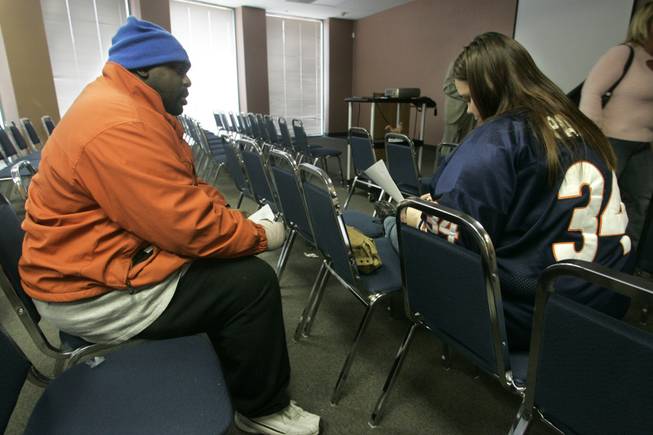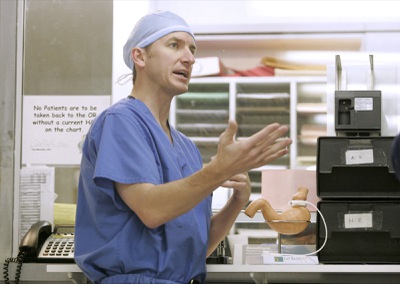
Vincent and Gail Daswell fill out paperwork for gastric band surgery after a seminar on the technique. Patients must watch what they eat because the surgery can be undermined by snacks and sugary drinks.
Sunday, Feb. 10, 2008 | 2 a.m.
There were some nights when Jim Bowen would wolf down a burger at a fast-food joint on the way home from work — and make a second stop to gobble down another burger.
Then, at home, he’d have dinner.
He weighed 340 pounds, had a 50-inch waist, took two medicines a day to control his diabetes, and others for his high blood pressure.
Gastric Band
Dr. James Atkinson of the Gastric Band Institute in Las Vegas, who has performed about 2,000 gastric bypass and band procedures, explains how the gastric band works. Related story: With surgery, pounds melt — if the patients stick.
In June Bowen, the chief financial officer at the Silverton, underwent gastric band surgery, a 30-minute outpatient procedure in which a surgeon placed a tight plastic collar, like a wristwatch, around the entry to his stomach, creating a pouch that holds about 10 percent of the stomach’s volume.
Now when Bowen eats, the pouch fills quickly. Each of his three daily meals weighs just 4 ounces, but he doesn’t feel hungry.
To be sure, there’s discipline involved in his new lifestyle; the gastric band is not a silver bullet. He could eliminate much of its benefit by sucking down sugary drinks or munching all day on snacks.
But for Bowen, the transformation has been life-changing.
Seven months after the surgery, he weighs 199 pounds, has a 34-inch waist and no longer needs medication for high blood pressure or diabetes — both of which are in remission. He’s 45 and weighs less than he did in college.
He’s among the morbidly obese Las Vegans who lost weight with the bariatric band procedure and in the process sent their diabetes into remission.
A study recently published in The Journal of the American Medical Association confirmed what bariatric surgeons have been saying for years, that the drastic weight loss from the gastric band is a remedy for diabetes, which can be caused by obesity. The study found complete remission of Type 2 diabetes was achieved in 73 percent of patients undergoing gastric band surgery, compared with 13 percent of a group who dieted and used medication. No serious complications were reported as a result of the surgery, the Journal said.
“By promoting greater weight loss, (the gastric band surgery) was far more effective than medical/behavioral therapy at improving diabetes,” the Journal concluded in an editorial.
But how to apply the study’s findings remains unclear, the Journal noted.
Dr. James Atkinson of the Gastric Band Institute in Las Vegas estimates that 500,000 people in Clark County could qualify for bariatric surgery, based on obesity statistics. The Centers for Disease Control and Prevention estimates that 33 percent of Americans are obese.
Atkinson, who has performed about 2,000 gastric bypass and band procedures, said the study confirms what he’s seen in his practice. Medical problems such as Type 2 diabetes, high blood pressure and sleep apnea — a disorder where breathing stops or slows during sleep — are often caused by obesity, he said, so bariatric surgery patients often find relief from the maladies when they drop weight. He said most patients lose about 50 percent of their excess weight in the first year after surgery.
That was good news to Christine Espinoza, who recently moved to Las Vegas and suffers from Type 2 diabetes.
Diabetes causes the body not to produce enough insulin, or not to absorb insulin, which is needed to convert glucose into energy. Type 2 diabetes is the most common form of the disease and can damage the eyes, kidneys, nerves or heart.
On a recent Saturday Espinoza’s eyes were locked on Atkinson during a seminar about the gastric band procedure. At age 50, she pats her belly and estimates there are an extra 100 pounds on her 5-foot frame, most of it from overeating. She also suffers from arthritis, so exercise is difficult.
“I couldn’t run to save my life,” she says. “To do simple things like getting up and down is hard.”
Gastric band surgery may be her best chance to be rid of diabetes, she said, adding that she was familiar with the new studies about the procedure sending the disease into remission.
“I’m tired of being sick,” she said.
Espinoza’s biggest barrier to the surgery is cost, which Atkinson estimates at $16,000 for the surgery and the first year of follow-up treatments. Most insurance companies cover some of the cost, but they also make the patient pay huge out-of-pocket costs, he said.
The upside from the extreme weight-loss surgery: About 85 percent of patients with Type 2 diabetes are cured, he said.
Atkinson said the benefits of the procedure can be quickly undermined by snacking and liquid calories. A White Chocolate Mocha Frappuccino from Starbucks is 550 calories that’ll slip right through the band.
Success requires a drastic change in behavior, he said.
Although the banded stomach will dramatically limit the amount of food consumed in one sitting, “if you eat between meals you still get calories,” he said.
The bands are the latest iteration of bariatric surgery, which has been around since the 1960s. Back then, doctors performed bypass operations so food would go through only two feet of intestine instead of 20, said Dr. Neil Hutcher, a Virginia surgeon who is the past president of the American Society for Metabolic & Bariatric Surgery. Patients could eat all they wanted and the body absorbed a minimal amount of the food, he said. But that procedure lost appeal because it caused chronic diarrhea.
Gastric bypass surgery was also developed in the 1960s and is today the most common weight-loss surgery. A surgeon creates a pouch above the stomach with staples or a band and reroutes it to the middle of the intestine.
Doctors say the gastric band procedure, approved in the United States in 2001, is much less invasive and is safer than the bypass — but requires much more behavior change. It’s usually done laparoscopically, using small incisions and long instruments to reach the stomach. The band includes a balloonlike collar that’s filled with saline solution, connected to a tube that runs to a port that’s attached to the abdominal wall, under the skin. As the patient loses weight, the stomach loses fat and the collar becomes loose. Doctors inject saline solution into the tube to keep the collar tight.
The number of bariatric surgeries has increased from 16,200 in 1992 to 205,000 in 2007, according to the American Society for Metabolic & Bariatric Surgery.
Atkinson and his partner do about 100 bariatric operations a month. The band is growing in popularity and now makes up about half the procedures.
The gastric band requires a greater patient commitment, Atkinson said, because with the bypass the weight loss and behavioral change are almost automatic. Almost all bypass patients lose about 80 percent of their excess weight in the first year because they have no choice, Atkinson said. But the range of weight loss is greater for band patients in the first year, depending on behavior. Band patients may lose only 15 percent of excess weight — versus the expected 50 percent — if they don’t do follow-up visits to tighten the band, or eat too many calories through snacking. But they could also lose up to 80 percent if they’re disciplined, he said.
Both procedures can be derailed in the long run by patient behavior, he said.
Vincent Daswell, 33, knows he needs to change his behavior.
He used to drive trucks but now he’s disabled, unable to play with his three boys, ages 16, 14 and 11.
Daswell weighs 348 pounds and suffers from diabetes, high blood pressure and sleep apnea. At night he wears a mask connected to a machine that pumps air into his lungs.
Daswell knows it will take exceptional effort to change his lifestyle and says the surgery is an appropriate launching point to interrupt the cascade of events — a kind of vicious circle — that have led to his obesity.
“Hopefully I’ll lose the sleep apnea so I won’t wake up in the middle of the night and eat, because that’s when I do my snacking,” he said. “It’s the snacking most of the time, and the portions, which are hard to control.”


Join the Discussion:
Check this out for a full explanation of our conversion to the LiveFyre commenting system and instructions on how to sign up for an account.
Full comments policy